Why Concrete's Colossal Footprint is More Complicated Than You Think (and Why That Matters to Everyone) - TreeHugger.com
April 25, 2011
Lloyd Alter
Design and Architecture
TreeHugger.com
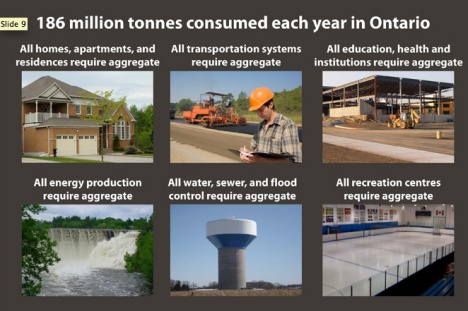
Images from Highland Group Slideshow, Open House, April 12: http://www.highlandcompanies.ca/index.php/slideshow/openhouse/#0
When one complains about the environmental footprint of concrete, the main issue is usually the carbon footprint that comes from the production of cement. But cement is only about 15% of concrete; the rest is aggregate, the rock that the cement binds together. As this slide from The Highland Companies shows, concrete and aggregate is a big part of infrastructure. And just north of Toronto, in Melancthon, the company wants to dig a honking big hole covering 2,316 acres, over 200 feet below the water table, to supply aggregate to the Greater Toronto Area.
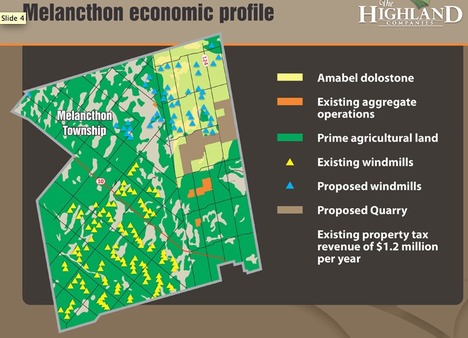
Images from Highland Group Slideshow, Open House, April 12: http://www.highlandcompanies.ca/index.php/slideshow/openhouse/#0
Many are against the project, claiming that it is really much more global; it is apparently owned by a Boston based hedge fund, the Baupost Group, run by value investor Seth Klarman. They are negotiating rail rights to Owen Sound on Georgian Bay, and the Council of Canadians says that the aggregate will be shipped to Panama to build the new supersized canal.
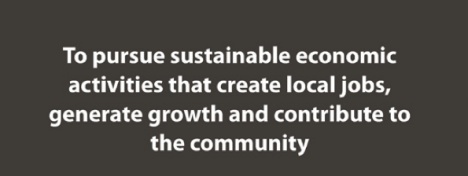
Images from Highland Group Slideshow, Open House, April 12: http://www.highlandcompanies.ca/index.php/slideshow/openhouse/#0
Everything these days is sustainable; the company promises sustainable jobs and money while the Citizens Alliance for a Sustainable Environment (Cause) claims that the land abuts a UNESCO Biosphere reserve), that a quarry 200 feet deep and over 2400 acres is going to be hard to remediate, that the repercussions of quarrying into this watershed could affect well over one million people that are downstream from, and served by, these watercourses. "
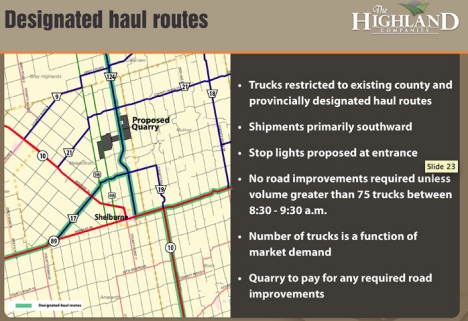
Images from Highland Group Slideshow, Open House, April 12: http://www.highlandcompanies.ca/index.php/slideshow/openhouse/#0
They do not even raise the issue of the number of gravel trucks that will be travelling down these beautiful country roads. It could be as many as 150 40 tonne trucks per hour, 24 hours a day, every day, all to serve this insane need for so much aggregate, which they are quoted in the Star as being " one of the foundations of our modern society."
But as a society, instead of being so efficient at the supply side of the equation, why are we not looking at the demand? Why do we need so much aggregate and cement and concrete? What could we do to reduce it?
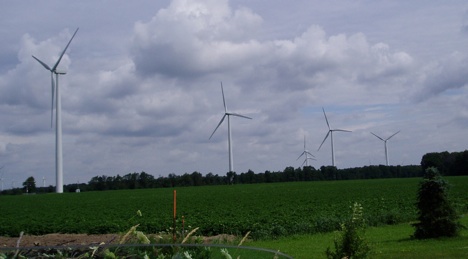
Farming potatoes and wind in Melancthon. Image credit Lloyd Alter
Steps to reduce our need for aggregate
1. Ban Sprawl. It takes the same amount of concrete to provide a road in front of 5 townhouses as it does to service one large lot single home in the suburbs. Huge amounts of the stuff service the sprawl industry.
2. Build in the true cost of externalities into the price of concrete. If the true costs of hauling buildings to the dump and their replacement with new concrete, including the CO2, the road damage, the cyclists killed, were all part of the equation, then the cost would be much higher. But those costs are not being paid by the Highland Group and Baupost, that is not how Seth Klarman works. In a profile of the Baupost Group in Hedge Fund Letters, they quote Klarman:
According to Klarman, "if only one word is to be used to describe what Baupost does, that word should be: 'Mispricing'. We look for mispricing due to over-reaction." Some of his favorite mispricing situations that arise from forced selling and complexity are spin-offs, forced selling by index funds, forced selling by institutions, bankruptcy, and accounting frauds. His ability to analyze these situations enables him to extract huge returns. In repeat situations like thrift conversions and real estate purchased from the Resolution Trust Corporations, Klarman was able to extract significant returns several times over until others were able to see the value, bid up the assets, and decrease the premiums. When the opportunities were no longer available, Klarman would move on.
What we have here is a mispriced asset, that would be a lot more expensive if the externalities were built in.
3. Encourage Renovation and Rehabilitation instead of Demolition and Replacement. We don't need to keep knocking down everything and sending it to the dump and replacing it with concrete, when we could fix what we have.
4. Use less aggregate and more recycled concrete. According to the Toronto Environmental Alliance:
This and more can and is being done in other jurisdictions. For example, of the 281 million tonnes of aggregates used in the UK, 67 million tonnes - about 24% - is recycled aggregate. In contrast, the Ontario Ministry of Natural Resources claims up to about 7.2% of Ontario's annual aggregate use is made up of recycled aggregate.
It is just crazy, digging up thousands of acres of farmland to make aggregate to pave thousands more acres of farmland. If we reduced demand by building things right, building them dense and just building less, perhaps we wouldn't have to do this kind of stuff.
As originally published here: http://www.treehugger.com/files/2011/04/colossal-footprint-of-concrete-aggregate.php
| Attachment | Size |
|---|---|
| 2011-04-25 Why Concrete's Colossal Footprint is more complicated _TreeHugger_.pdf | 277.14 KB |
